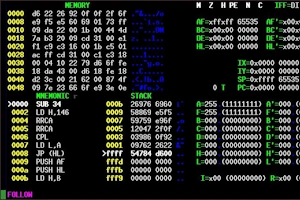Qt WidgetsにおけるQTableWidget::itemPressed()シグナルの解説
Qt WidgetsにおけるQTableWidget::itemPressed()の解説
QTableWidget::itemPressed() は、Qt Widgetsライブラリで提供されるQTableWidgetクラスのシグナルで、テーブル内のアイテムがクリックされたときに発生します。このシグナルは、クリックされたアイテムに関する情報を取得するために使用できます。
シグナルの引数
QTableWidget::itemPressed()シグナルは、以下の引数を渡します。
- QModelIndex index: クリックされたアイテムのインデックス
- QMouseEvent event: クリックイベント
シグナルの使用方法
QTableWidget::itemPressed()シグナルを接続するには、connect()関数を使用します。以下の例は、シグナルをスロットに接続する方法を示しています。
connect(tableWidget, &QTableWidget::itemPressed, this, &MyClass::onItemPressed);
スロットの実装
スロットでは、渡された引数を使用して、クリックされたアイテムに関する情報にアクセスできます。
void MyClass::onItemPressed(const QModelIndex &index)
{
int row = index.row();
int col = index.column();
QVariant data = index.data();
// クリックされたアイテムの情報を使用して処理を行う
}
例
以下の例は、QTableWidget::itemPressed()シグナルを使用して、クリックされたアイテムの行と列をコンソールに出力するコードを示しています。
#include <QApplication>
#include <QTableWidget>
int main(int argc, char *argv[])
{
QApplication app(argc, argv);
QTableWidget tableWidget;
tableWidget.setRowCount(5);
tableWidget.setColumnCount(10);
for (int row = 0; row < tableWidget.rowCount(); ++row) {
for (int col = 0; col < tableWidget.columnCount(); ++col) {
QString text = QString("Row %1, Col %2").arg(row + 1).arg(col + 1);
tableWidget.setItem(row, col, new QTableWidgetItem(text));
}
}
connect(&tableWidget, &QTableWidget::itemPressed, &tableWidget, &QTableWidget::onItemPressed);
tableWidget.show();
return app.exec();
}
void QTableWidget::onItemPressed(const QModelIndex &index)
{
int row = index.row();
int col = index.column();
qDebug() << "Clicked row:" << row + 1;
qDebug() << "Clicked column:" << col + 1;
}
このコードを実行すると、テーブル内のアイテムをクリックすると、そのアイテムが行と列がコンソールに出力されます。
QTableWidget::itemPressed()シグナルは、テーブル内のアイテムがクリックされたときに発生するシグナルです。このシグナルを使用して、クリックされたアイテムに関する情報にアクセスし、処理を行うことができます。
Sure, here are some sample codes for QTableWidget::itemPressed() signal in C++:
Print row and column of clicked item:
#include <QApplication>
#include <QTableWidget>
int main(int argc, char *argv[])
{
QApplication app(argc, argv);
QTableWidget tableWidget;
tableWidget.setRowCount(5);
tableWidget.setColumnCount(10);
for (int row = 0; row < tableWidget.rowCount(); ++row) {
for (int col = 0; col < tableWidget.columnCount(); ++col) {
QString text = QString("Row %1, Col %2").arg(row + 1).arg(col + 1);
tableWidget.setItem(row, col, new QTableWidgetItem(text));
}
}
connect(&tableWidget, &QTableWidget::itemPressed, &tableWidget, &QTableWidget::onItemPressed);
tableWidget.show();
return app.exec();
}
void QTableWidget::onItemPressed(const QModelIndex &index)
{
int row = index.row();
int col = index.column();
qDebug() << "Clicked row:" << row + 1;
qDebug() << "Clicked column:" << col + 1;
}
Open a new window with clicked item's data:
#include <QApplication>
#include <QTableWidget>
#include <QMessageBox>
int main(int argc, char *argv[])
{
QApplication app(argc, argv);
QTableWidget tableWidget;
tableWidget.setRowCount(5);
tableWidget.setColumnCount(10);
for (int row = 0; row < tableWidget.rowCount(); ++row) {
for (int col = 0; col < tableWidget.columnCount(); ++col) {
QString text = QString("Row %1, Col %2").arg(row + 1).arg(col + 1);
tableWidget.setItem(row, col, new QTableWidgetItem(text));
}
}
connect(&tableWidget, &QTableWidget::itemPressed, &tableWidget, &QTableWidget::onItemPressed);
tableWidget.show();
return app.exec();
}
void QTableWidget::onItemPressed(const QModelIndex &index)
{
int row = index.row();
int col = index.column();
QVariant data = index.data();
QMessageBox::information(this, "Item Data", QString("Row: %1\nColumn: %2\nData: %3")
.arg(row + 1).arg(col + 1).arg(data.toString()));
}
Edit clicked item's data:
#include <QApplication>
#include <QTableWidget>
#include <QInputDialog>
int main(int argc, char *argv[])
{
QApplication app(argc, argv);
QTableWidget tableWidget;
tableWidget.setRowCount(5);
tableWidget.setColumnCount(10);
for (int row = 0; row < tableWidget.rowCount(); ++row) {
for (int col = 0; col < tableWidget.columnCount(); ++col) {
QString text = QString("Row %1, Col %2").arg(row + 1).arg(col + 1);
tableWidget.setItem(row, col, new QTableWidgetItem(text));
}
}
connect(&tableWidget, &QTableWidget::itemPressed, &tableWidget, &QTableWidget::onItemPressed);
tableWidget.show();
return app.exec();
}
void QTableWidget::onItemPressed(const QModelIndex &index)
{
int row = index.row();
int col = index.column();
QString currentText = index.data().toString();
bool ok;
QString newText = QInputDialog::getText(this, "Edit Item Data",
QString("Enter new text for row %1, column %2:").arg(row + 1).arg(col + 1),
&ok, currentText);
if (ok && !newText.isEmpty()) {
tableWidget.setItem(row, col, new QTableWidgetItem(newText));
}
}
Check if clicked item is editable:
Sure, here are some additional methods for using the QTableWidget::itemPressed() signal:
Accessing the clicked item's text:
void MyClass::onItemPressed(const QModelIndex &index)
{
QString text = index.data().toString();
qDebug() << "Clicked item text:" << text;
}
Checking if the clicked item is valid:
void MyClass::onItemPressed(const QModelIndex &index)
{
if (index.isValid()) {
// Process the clicked item
} else {
qDebug() << "Invalid item clicked";
}
}
Getting the row and column of the clicked item separately:
void MyClass::onItemPressed(const QModelIndex &index)
{
int row = index.row();
int col = index.column();
qDebug() << "Clicked row:" << row;
qDebug() << "Clicked column:" << col;
}
Using the QMouseEvent object to get more information about the click:
void MyClass::onItemPressed(const QModelIndex &index, const QMouseEvent *event)
{
int row = index.row();
int col = index.column();
qDebug() << "Clicked row:" << row;
qDebug() << "Clicked column:" << col;
if (event->button() == Qt::LeftButton) {
qDebug() << "Left button clicked";
} else if (event->button() == Qt::RightButton) {
qDebug() << "Right button clicked";
} else {
qDebug() << "Other button clicked";
}
}
Using the QTableWidgetItem object to get more information about the clicked item:
void MyClass::onItemPressed(const QModelIndex &index)
{
QTableWidgetItem *item = index.data(Qt::DisplayRole).value<QTableWidgetItem *>();
if (item) {
qDebug() << "Clicked item text:" << item->text();
qDebug() << "Clicked item background color:" << item->backgroundColor();
qDebug() << "Clicked item font:" << item->font();
}
}
These are just a few examples of how to use the QTableWidget::itemPressed() signal. The specific implementation will depend on your specific needs.
Additional Tips:
- You can use the
itemDoubleClicked()signal to handle double-clicks on items. - You can use the
cellEntered()andcellExited()signals to track when the mouse enters or leaves a cell. - You can use the
itemSelectionChanged()signal to handle changes to the selected items in the table.
I hope this helps!
Qt GUIプログラミングにおけるVulkanスワップチェーンイメージビュー:応用例とベストプラクティス
QVulkanWindow::swapChainImageView()関数は、Vulkanスワップチェーンイメージに対応するイメージビューを取得するために使用されます。イメージビューは、シェーダープログラムでテクスチャとしてサンプリングしたり、レンダリングターゲットとして使用したりするために必要なオブジェクトです。
Qt GUI アプリケーション開発者必見!QTextBlockUserData クラスを使いこなしてテキスト処理を効率化
QTextDocument は、テキストをフォーマットして表示するためのクラスです。テキスト文書は、段落、行、文字などの要素で構成されます。QTextBlockUserData クラスは、これらの要素の一つである テキストブロック に、アプリケーション固有のデータを関連付けるために使用されます。

Qt GUIにおけるQVulkanInstance::removeDebugOutputFilter()解説
QVulkanInstance::removeDebugOutputFilter()は、Vulkanデバッグ出力のフィルタリング機能を無効にするためのQt GUIクラスの関数です。詳細機能: デバッグ出力フィルタは、Vulkan APIからのデバッグメッセージをフィルタリングする機能を提供します。 特定のメッセージレベルやカテゴリのメッセージを出力しないように設定できます。

Qt GUI チュートリアル:QVector3D::operator+=() を使用して 3Dベクトルを加算する
使用方法この例では、v1 と v2 という 2つの QVector3D オブジェクトが定義されています。v1 += v2 という式は、v1 の各成分に v2 の対応する成分を加算します。結果として、v1 は (5.0f, 7.0f, 9.0f) という新しいベクトルになります。

Qt GUIにおけるQTextDocument::documentLayout()詳解
QTextDocumentは、テキスト、画像、表などを含むリッチテキストドキュメントを表現するクラスです。documentLayout()関数は、ドキュメント内のテキストどのように配置するかを定義するQAbstractTextDocumentLayoutオブジェクトを返します。


Qt WidgetsでQColormap::size()を使ってカラーマップのサイズを取得する方法
**QColormap::size()**の使い方は以下の通りです。**QColormap::size()**を使用する際の注意点は以下の通りです。QColormapオブジェクトは、デフォルトで16色分のカラーマップを持っています。**QColormap::size()**を使用して取得したサイズは、QColormapオブジェクトに追加された色の数によって変化します。
Qt Widgets:QDateTimeEdit::fixup()で日付時刻入力をバリデーションと修正
QDateTimeEdit::fixup() は、Qt Widgetsライブラリで提供される QDateTimeEdit クラスの仮想関数です。この関数は、ユーザーが入力したテキストを修正するために使用されます。具体的には、以下の処理を行います。
QRgba64::operator=()のサンプルコード集:Qt GUIでの実践例
QRgba64は、Qt GUIで使用される構造体で、赤、緑、青、アルファの4つの色チャンネルを64ビット整数で表現します。各チャンネルは16ビットで構成され、0から65535までの値を取ることができます。QRgba64::operator=()は、QRgba64型変数に新しい値を代入するために使用されます。この関数は、以下の2つの異なる形式で使用できます。
Qt GUI アプリケーション開発:ドラッグアンドドロップの完全ガイド
機能: ドラッグ操作をキャンセルします。戻り値: なしスレッド: どのスレッドからでも呼び出すことができます。注意点: ドラッグ操作が完了する前に呼び出す必要があります。上記のように、QDrag::cancel() を呼び出すことで、ドラッグ操作をキャンセルすることができます。
【Qt GUI】画像ファイルをモノクロ画像に変換してQBitmapを作成する:QBitmap::fromData()の使い方
QBitmap::fromData()は、Qt GUIでucharデータからQBitmapオブジェクトを作成するための静的関数です。QBitmapは、主にカスタムカーソルやブラシの作成、領域オブジェクトの構築、ピクセルマップやウィジェットのマスク設定などに使用されるモノクロ(1ビット深度)のピクセルマップです。